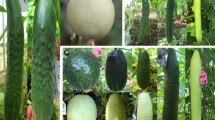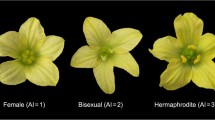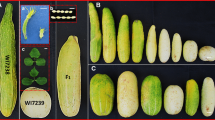Abstract
Key message
A 14 bp deletion in CsACS2 gene encoding a truncated loss-of-function protein is responsible for elongated fruit shape and perfect flowers in cucumber.
Abstract
In cucumber (Cucumis sativus L.), sex expression and fruit shape are important components of biological and marketable yield. The association of fruit shape and sex expression is a very interesting phenomenon. The sex determination is controlled primarily by the F (female) and M (monoecy) loci. Homozygous recessive mm plants bear bisexual (perfect) flowers, and the fruits are often round shaped. CsACS2 encoding the 1-aminocyclopropane-1-carboxylic acid synthase has been shown to be the candidate gene for the m locus. We recently identified an andromonoecious cucumber line H38 that has bisexual flowers but elongated fruits. To rapidly clone this monoecious gene in H38, we developed a tri-parent mapping strategy, which took advantage of the high-density Gy14 × 9930 cucumber genetic map and the powder of bulk segregant analysis. Microsatellite markers from the Gy14 × 9930 map were used to screen two pairs of unisexual and bisexual bulks constructed from H38 × Gy14 and H38 × 9930 F2 populations. Polymorphic markers were identified and used to quickly develop a framework map and place the monoecious locus of H38 in cucumber chromosome 1. Further fine mapping allowed identification of a novel allele, m-1, at the monoecious locus to control the bisexual flower in H38, which was due to a 14 bp deletion in the third exon of the CsACS2 gene encoding a truncated loss-of-function protein of the cucumber 1-aminocyclopropane-1-carboxylic acid synthase. This new allele provides a valuable tool in understanding the molecular mechanisms of CsACS2 in the relationships of sex determination, fruit shape, and CsACS activities in cucumber.





Similar content being viewed by others
References
Abdelmohsin ME and Pitrat M (2008) Pleiotropic effect of sex expression on fruit shape in melon. Cucurbitaceae 2008, Proceedings of IXth EUCARPIA Meeting on Genetics and Breeding of Cucurbitaceae (Pitrat M ed), INRA, Avignon (France), 21–24 May 2008
Amano M, Mochizuki A, Kawagoe Y, Iwahori K, Niwa K, Svoboda J, Maeda T, Imura Y (2013) High-resolution mapping of zym, a recessive gene for Zucchini yellow mosaic virus resistance in cucumber. Theor Appl Genet 126:2983–2993
Boualem A, Troadec C, Kovalski I, Sari M-A, Perl-Treves R, Bendahmane A (2009) A conserved ethylene biosynthesis enzyme leads to andromonoecy in two Cucumis species. PLoS One 4:e6144
Boualem A, Fleurier S, Troadec C, Audigier P, Kumar APK, Chatterjee M, Alsadon AA, Sadder MT, Wahb-Allah MA, Al-Doss AA, Bendahmane A (2014) Development of a Cucumis sativus TILLinG platform for forward and reverse genetics. PLoS One 9:e97963
Bulens I, van de Poel B, Hertog ML, de Proft MP, Geeraerd AH, Nicolaï BM (2011) Protocol: an updated integrated methodology for analysis of metabolites and enzyme activities of ethylene biosynthesis. Plant Methods 7:17
Cavagnaro PF, Senalik DA, Yang LM, Simon PW, Harkins TT, Kodira C, Huang SW, Weng YQ (2010) Genome-wide characterization of simple sequence repeats in cucumber (Cucumis sativus L.). BMC Genom 11:569
Chae HS, Faure F, Kieber JJ (2003) The eto1, eto2, and eto3 mutations and cytokinin treatment increase ethylene biosynthesis in Arabidopsis by increasing the stability of ACS protein. Plant Cell 15:545–559
Cramer CS, Wehner TC (2000) Path analysis of the correlation between fruit number and plant traits of cucumber populations. HortScience 35:708–711
Galun E (1961) Study of the inheritance of sex expression in the cucumber, the interactions of major genes with modifying genetic and non-genetic factors. Genetica 32:134–136
Horejsi T, Staub JE (1999) Genetic variation in cucumber (Cucumis sativus L.) as assessed by random amplified polymorphic DNA. Genet Res Crop Evol 46:337–350
Huai Q, Xia Y, Chen Y, Callahan B, Li N, Ke H (2001) Crystal structures of 1-aminocyclopropane-1-carboxylate (ACC) synthase in complex with aminoethoxyvinylglycine and pyridoxal-5′-phosphate provide new insight into catalytic mechanisms. J Biol Chem 276:38210–38216
Huang SW, Li RQ, Zhang ZH, Li L, Gu XF, Fan W et al (2009) The genome of the cucumber, Cucumis sativus L. Nat Genet 41:1275–1281
Kamachi S, Sekimoto H, Kondo N, Sakai S (1997) Cloning of a cDNA for a 1-aminocyclopropane-1-carboxylate synthase that is expressed during development of female flowers at the apices of Cucumis sativus L. Plant Cell Physiol 38:1197–1206
Kamachi S, Mizusawa H, Matsuura S, Sakai S (2000) Expression of two 1-aminocyclopropane-1-carboxylate synthase genes, CS-ACS1 and CS-ACS2, correlated with sex phenotypes in cucumber plants (Cucumis sativus L.). Plant Biothnol 17:69–74
Kennard WC, Poetter K, Dijkhuizen A, Meglic V, Staub JE, Havey M (1994) Linkages among RFLP, RAPD, isozyme, disease resistance, and morphological markers in narrow and wide crosses of cucumber. Theor Appl Genet 89:42–48
Knopf RR, Trebitsh T (2006) The female-specific CS-ACS1G gene of cucumber. A case of gene duplication and recombination between the non-sex-specific 1-aminocyclopropane-1-carboxylate synthase gene and a branched-chain amino acid transaminase gene. Plant Cell Physiol 47:1217–1228
Kosambi DD (1944) The estimation of map distances from recombination values. Ann Eugen 12:172–175
Kubicki B (1962) Inheritance of some characters in muskmelons (Cucumis melo). Genet Pol 3:265–274
Kubicki B (1969) Investigations on sex determination in cucumber (Cucumis sativus L.). VII. Andromonoecism and hermaphroditism. Genet Pol 10:101–120
Lander ES, Green P, Abrahamson J, Barlow A, Daly MJ, Lincoln SE, Newberg LA (1987) MAPMARKER: an interactive computer package for constructing primary genetic linkage maps of experimental and natural population. Genomics 1:174–181
Li N, Mattoo AK (1994) Deletion of the carboxyl-terminal region of 1-aminocyclopropane-1-carboxylic acid synthase, a key protein in the biosynthesis of ethylene, results in catalytically hyperactive, monomeric enzyme. J Biol Chem 269:6908–6917
Li Z, Pan JS, Guan Y, Tao QY, He HL, Si LT, Cai R (2008) Development and fine mapping of three co-dominant SCAR markers linked to the M/m gene in the cucumber plant (Cucumis sativus L.). Theor Appl Genet 117:1253–1260
Li Z, Huang SW, Liu SQ, Pan JS, Zhang ZH, Tao QY, Shi QX, Jia ZQ, Zhang WW, Chen HM, Si LT, Zhu LH, Cai R (2009) Molecular isolation of the M gene suggests that a conserved-residue conversion induces the formation of bisexual flowers in cucumber plants. Genetics 182:1381–1385
Li Z, Wang S, Tao QY, Pan JS, Si LT, Gong ZH, Cai R (2012) A putative positive feedback regulation mechanism in CsACS2 expression suggests a modified model for sex determination in cucumber (Cucumis sativus L.). J Exp Bot 63:4475–4484
Li YH, Wen CL, Weng YQ (2013) Fine mapping of the pleiotropic locus B for black spine and orange mature fruit color in cucumber identifies a 50 kb region containing a R2R3-MYB transcription factor. Theor Appl Genet 126:2187–2196
Lizada MCC, Yang SF (1979) A simple and sensitive assay for 1-aminocyclopropane-1-carboxylic acid. Anal Biochem 100:140–145
Loy JB (2006) Fruit size in melon in monoecious and andromonoecious isolines. Cucurbit Genetics Cooperative Report no 28–29, pp 12–13
Mibus H, Tatlioglu T (2004) Molecular characterization and isolation of the F/f gene for femaleness in cucumber (Cucumis sativus L.). Theor Appl Genet 109:1669–1676
Michelmore RW, Paran I, Kesseli RV (1991) Identification of markers linked to disease resistance genes by bulked segregant analysis: a rapid method to detect markers in specific genomic regions by using segregating populations. Proc Natl Acad Sci USA 88:9828–9832
Ren Y, Zhang ZH, Liu JH, Staub JE, Han YH, Cheng ZC, Li XF, Lu JY, Miao H, Kang HX, Xie BY, Gu XF, Wang XW, Du YC, Jin WW, Huang SW (2009) An integrated genetic and cytogenetic map of the cucumber genome. PLoS One 4:e5795
Robinson RW (1978) Association of fruit shape and sex expression in the cucumber. Cucurbit Genetics Cooperative Report 1: 10 (Article 7)
Rosa JT (1928) The inheritance of flower types in Cucumis and Citrullus. Hilgardia 3:233–250
Rottmann WH, Peter GF, Oeller PW, Keller JA, Shen NF, Nagy BP, Taylor LP, Campbell AD, Theologis A (1991) 1-aminocyclopropane-1-carboxylate synthase in tomato is encoded by a multigene family whose transcription is induced during fruit and floral senescence. J Mol Biol 222:937–961
Sakata Y, Fukino N, Ohara T, Sugiyama M, Yoshioka Y (2013) Effect of monoecious trait on fruit shape and total soluble solid contents of melon. Hort Res (Japan) 12:15–22
Serquen FC, Bacher J, Staub JE (1997) Genetic analysis of yield components in cucumber at low density. J Am Soc Hort Sci 122:522–528
Tarun AS, Lee JS, Theologis A (1998) Random mutagenesis of 1-aminocyclopropane-1-carboxylate synthase: a key enzyme in ethylene biosynthesis. Proc Natl Acad Sci USA 95:9796–9801
Trebitsh T, Staub JE, O’Neill SD (1997) Identification of a 1-aminocyclopropane-1-carboxylic acid synthase gene linked to the Female (F) locus that enhances female sex expression in cucumber. Plant Physiol 113:987–995
Vogel JP, Woeste KW, Theologis A, Kieber JJ (1998) Recessive and dominant mutations in the ethylene biosynthetic gene ACS5 of Arabidopsis confer cytokinin insensitivity and ethylene overproduction, respectively. Proc Natl Acad Sci USA 95:4766–4771
Wang GL, Paterson AH (1994) Assessment of DNA pooling strategies for mapping of QTLs. Theor Appl Genet 88:355–361
Wang XF, Goshe MB, Soderblom EJ, Phinney BS, Kuchar JA, Li J, Asami T, Yoshida S, Huber SC, Clouse SD (2005) Identification and functional analysis of in vivo phosphorylation sites of the Arabidopsis BRASSINOSTEROID-INSENSITIVE1 receptor kinase. Plant Cell 17:1685–1703
White MF, Vasquez J, Yang SF, Kirsch JF (1994) Expression of apple 1-aminocyclopropane-1-carboxylate synthase in Escherichia coli: kinetic characterization of wild-type and active-site mutant forms. Proc Natl Aced Sci USA 91:12428–12432
Yang LM, Koo D-H, Li YH, Zhang XJ, Luan FS, Havey MJ, Jiang JM, Weng YQ (2012) Chromosome rearrangements during domestication of cucumber as revealed by high-density genetic mapping and draft genome assembly. Plant J 71:895–906
Acknowledgments
The authors wish to thank Professors Huanwen Meng, Xiaofeng Wang, and Dr. Yanfeng Zhang (Northwest A&F University) for their assistance with cucumber materials and immunoblot analysis in this study. This work was supported by the National Natural Science Foundation of China (No. 31471879 and No. 31272185), the Innovation of Agricultural Science and Technology in Shaanxi Province (No. 2015NY081), and the Basic Scientific Research Fund from Northwest A&F University (No. QN2012010).
Author information
Authors and Affiliations
Corresponding author
Ethics declarations
Conflict of interest
The authors declare that they have no conflict of interest.
Additional information
Communicated by S. Huang.
J. Tan and Q. Tao have contributed equally to this work.
Electronic supplementary material
Below is the link to the electronic supplementary material.
Rights and permissions
About this article
Cite this article
Tan, J., Tao, Q., Niu, H. et al. A novel allele of monoecious (m) locus is responsible for elongated fruit shape and perfect flowers in cucumber (Cucumis sativus L.). Theor Appl Genet 128, 2483–2493 (2015). https://doi.org/10.1007/s00122-015-2603-0
Received:
Accepted:
Published:
Issue Date:
DOI: https://doi.org/10.1007/s00122-015-2603-0




